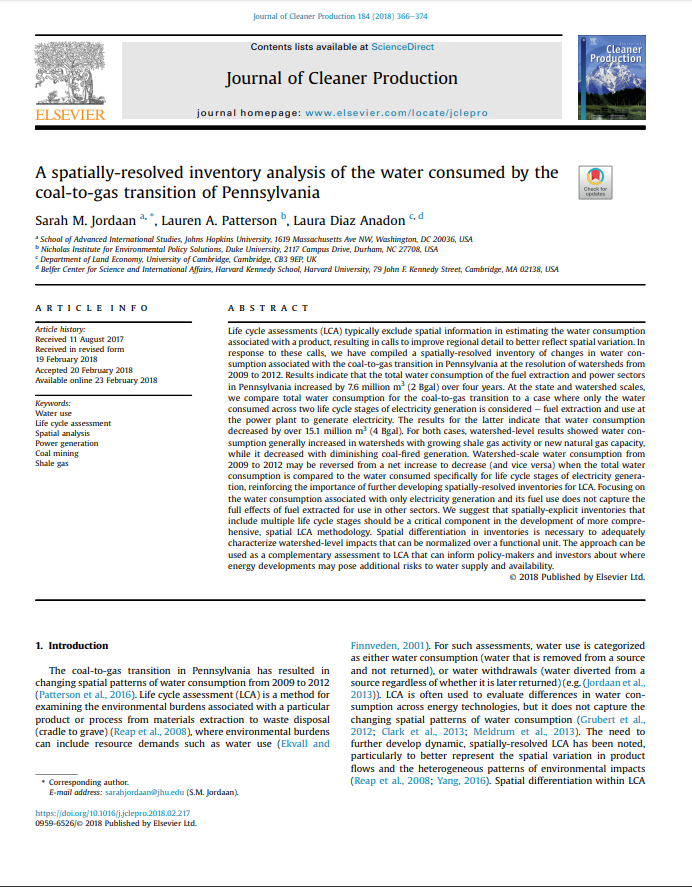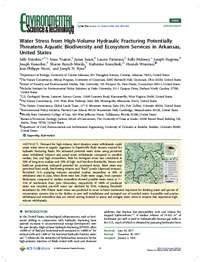Publications
EPA’s Methane Proposal for the Oil and Gas Sector – A Strong Foundation to Reduce Methane Emissions and Regulatory Path for More
In the months leading up to the UN climate conference in Glasgow (COP26), the United States and the European Union made a global methane pledge to reduce their collective methane emissions 30 percent from 2020 by 2030. In November, with the COP26 underway, the U.S.
LNG Supply Chains: A Supplier-Specific Life-Cycle Assessment for Improved Emission Accounting
Global trade in liquefied natural gas (LNG) is growing significantly, as is interest in the life-cycle greenhouse gas (GHG) emissions associated with LNG. Most assessments of life-cycle GHG emissions from LNG have employed national or regional average emission estimates; however, there is significant variability in emissions across different suppliers and across the natural gas supply chain. This work describes a framework for compiling supplier-specific GHG emission data for LNG, from the producing well to regasification at the destination port.
The Effect of Pennsylvania's 500 ft Surface Setback Regulation on Siting Unconventional Natural Gas Wells Near Buildings: An Interrupted Time-Series Analysis
This study evaluates the Pennsylvania state policy that set back the unconventional natural gas well-to-building requirement from 200 ft. to 500 ft. and finds that exemptions are an important and underappreciated aspect of oil and gas well setback rulemaking and highlights the relevance of other health-protective regulatory tools often promulgated alongside setbacks.
Population Allocation at the Housing Unit Level: Estimates around Underground Natural Gas Storage Wells in PA, OH, NY, WV, MI, and CA
Spatially accurate population data are critical for determining health impacts from many known risk factors. However, the utility of the increasing spatial resolution of disease mapping and environmental exposures is limited by the lack of receptor population data at similar sub-census block spatial scales.
Methods
Measuring and Managing the Unknown: Methane Emissions from the Oil and Gas Value Chain
Tracking and reducing methane emissions from oil and gas operations needs an innovative approach, according to new report from the C.D. Howe Institute. In “Measuring and Managing the Unknown: Methane Emissions from the Oil and Gas Value Chain” authors Sarah Marie Jordaan and Kate Konschnik highlight the growing pressure on industry and policymakers to address the “unknown” factor in greenhouse gas emissions and propose a regulatory approach that remains open to new technologies.
Private Environmental Governance in Oil and Gas: Unlocking the Complex Universe of Leading Management Practices
In the United States, expansion of onshore fracturing and horizontal drilling technologies has sparked calls for greater control of industry impacts. Alongside fractured regulatory efforts, a broad private governance movement has encouraged adoption of voluntary measures—often called “best management practices.” To explore the role of best management practices in unconventional oil and natural gas production, this article in the Florida State Journal of Land Use & Environmental Law focuses on surface spills of hydrocarbons, drilling wastes, fracturing fluid, and wastewater at production sites.
A Spatially-Resolved Inventory Analysis of the Water Consumed by the Coal-to-Gas Transition of Pennsylvania
In the Journal of Cleaner Production, the Nicholas Institute for Environmental Policy Solutions Lauren Patterson and her co-authors look at changes in water consumption related to transitions from coal to natural gas in Pennsylvania from 2009 to 2012. The study provides the first comprehensive representation of changing water consumption patterns associated with the state’s coal-to-gas transition at a watershed level for both extraction of the resources to the generation of electricity with coal and natural gas.
Reducing Fugitive Methane Emissions from the North American Oil and Gas Sector: A Proposed Science-Policy Framework
Atmospheric methane concentrations continue to increase globally, despite a pledge in 2016 from the leaders of the United States, Canada, and Mexico to reduce methane emissions from each country’s oil and gas sector. Additionally, the trilateral methane pledge faces more challenges as the Trump Administration seeks to reverse federal methane research and control efforts. Efforts to measure and control fugitive methane emissions do not presently proceed within a coherent framework that integrates science and policy. A new article in the journal Climate Policy suggests that collectively or individually, the countries, individual agencies, or private stakeholders could use the proposed North American Methane Reduction framework to direct research, enhance monitoring and evaluate mitigation efforts, and improve the chances that continental methane reduction targets will be achieved.
Water Stress from High-Volume Hydraulic Fracturing Potentially Threatens Aquatic Biodiversity and Ecosystem Services in Arkansas, United States
Demand for high-volume, short duration water withdrawals could create water stress to aquatic organisms in the Fayetteville Shale streams of Arkansas sourced for hydraulic fracturing fluids this article in the journal Environmental Science and Technology suggests. Authors estimate potential water stress using permitted water withdrawal volumes and actual water withdrawals compared to monthly median, low, and high streamflows. Findings indicate that freshwater usage for hydraulic fracturing could potentially affect aquatic organisms in 7-51 percent of the catchments depending on the month. If 100 percent of wastewater was recycled, the potential impact drops. Authors suggest that improved monitoring and access to water withdrawal and streamflow data are needed to ensure protection of streams not only as sources of drinking water, but aquatic habitats.
Unconventional Oil and Gas Spills: Risks, Mitigation Priorities and States Reporting Requirements
An analysis led by the Nicholas Institute for Environmental Policy Solutions, which appears in the journal Environmental Science & Technology, concludes that making state spill data more uniform and accessible could provide stakeholders with important information on where to target efforts for locating and preventing future spills. However, reporting requirements differ across states, requiring considerable effort to make the data usable for analysis. By examining state-level spill data, it finds that 2 to 16 percent of hydraulically fractured oil and gas wells across Colorado, New Mexico, North Dakota and Pennsylvania spill hydrocarbons, chemical-laden water, hydraulic fracturing fluids and other substances each year. The study characterizes spills associated with unconventional oil and gas development at 31,481 wells hydraulically fractured or "fracked" in the four states between 2005 and 2014, identifying 6,648 spills in the 10-year period.










